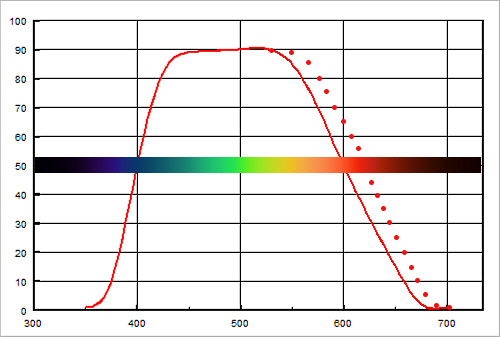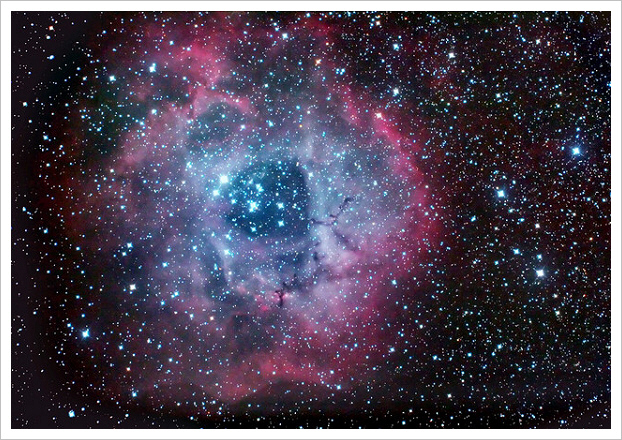

The Canon 60Da Previewed and Explained

Canon have just announced a version of the EOS 60D which has been enhanced for astrophotography use. It's designated the EOS 60Da. Some of you might remember a similar EOS 20Da which Canon made available several years go. The major feature of both cameras is a modified filter in front of the sensor. Since there seems to be a lot of confusion around about what this means I thought I'd try to explain it in a little more detail, as well as previewing the camera.
CMOS sensors are intrinsically sensitive to infrared radiation. So much so that without a filter in front of the sensor that blocks IR it would not be possible to record images in visible light the way that the eye sees them. By definition the eye can't see infrared.
The filter used to block IR also blocks some of the deep red visible light because filters of this type don't have a steep cutoff. If they blocked no visible light at all they'd let though quite a lot of near IR light. On the other hand if they blocked all near IR light, they'd block quite a bit of the red. The compromise Canon use transmits most red quite well and blocks most IR. Below, the red line represents a typical transmission spectrum of a filter used on a digital camera. The dotted line shows the curve that an H-Alpha modified filter might have. These are illustrations, not actual data for the EOS 60D/60Da.

Now as regards astrophotography, there's lots of hydrogen in the universe. More hydrogen than anything else actually. Under certain conditions hydrogen can emit monochromatic light at 656.28nm. That's deep red. A Helium-Neon laser operates at 632nm and some red laser pointers operate around 650nm. Below is a fairly accurate representation of the visible spectrum showing where H-Alpha light is in relation to the rest of the spectrum and HeNe laser light.

Though Canon don't give any exact numbers of how much light the filter transmits at the H-Alpha wavelength they do say that it's 3x as much as the standard 60D filter. They also say it has 20% higher transmission than the 60D filter. If you put these two numbers together, it looks like the standard 60D filter must transmit 10% of the H-Alpha light and the modified filter in the 60Da must transmit 30% of the H-Alpha light. Canon haven't published these numbers, but they seem to be consistent with what they have said on the subject.
The higher H-Alpha light sensitivity enables the red color of many nebulae (due to emission from Hydrogen) to be recorded better. A typical nebula emitting H-Aplha light is shown in the image below:

Rosette Nebula, NGC 2237
Just to clear up something, in their press release it says "...This new camera enables an accurate depiction of a part of our solar system which is hard to achieve with conventional cameras but should be enjoyed and celebrated...". This is pretty much wrong. There's not much in the solar system that emits H-Alpha light. Planets don't, the moon doesn't and asteroids don't. Comets may shine dimly in H-Alpha. The sun, being made mostly of hydrogen, shines strongly in H-Alpha light, but much, much more strongly in all the rest of the visible spectrum so without some very specialized (and expensive) equipment, photographing the sun in H-Alpha light isn't going to be something you can do with a EOS D60a. Even if you had the right telescope and filter, the sun is bright enough in H-Alpha light the you wouldn't need the extra sensitivity of the EOS D60a. The main targets for astrophotography which shine with H-Alpha light are the nebulae which lie in our Galaxy but are WAY beyond the solar system. They aren't bright so the added sensitivity of the D60a is very useful.
In their press release Canon say "...Enhanced noise reduction on the EOS 60Da sensor offers photographers the ability to experiment with the wide array of ISO settings and increased ISO speeds up to 6400 expandable to 12800...". It's not at all clear if "enhanced noise reduction" refers to noise reduction that's better than that of the D60 or if "enhanced" is just a descriptor they've thrown in to mean "good" or "excellent". The standard D60 also has ISO speeds up to 6400 and is expandable to ISO 12800.
Is the EOS 60Da an infrared camera? Can it be used for normal photography?
The EOS 60Da is not an infrared camera. Infrared modified cameras have a filter that transmits IR light and blocks visible light. The 60Da, like the 60D is just the opposite. They have filters that transmit visible light and block IR light.
However, I'd expect the EOS 60Da to show a little higher near IR sensitivity than a normal EOS 60D simply because the filter won't have a sharp cutoff and if the transmission is higher in the deep red it's also likely to be a little higher in the near IR. Nothing like the sensitivity of an IR converted camera though.
As for visible light use, the EOS 60Da should be fine, though it may show a slightly higher tendency to blow out the red channel under some circumstances and it may need a custom white balance to get the most accurate colors.
How much and where can I get one?
The price of the EOS 60Da is $1499 (the EOS 60D currently sells for around $899, so you're paying and extra $600 for the "astro" version). It should be available this month from selected dealers like Adorama and B&H. The price includes an AC adapter, which is nice since the long exposures often required for astrophotography can drain the camera's battery.
Here's what Canon have actually said about the EOS D60a

New Canon EOS 60Da DSLR Camera For Astronomy Enthusiasts Captures The True Colors Of The Cosmos
LAKE SUCCESS, N.Y., April 3, 2012 – Canon U.S.A., Inc., a leader in digital imaging solutions, today introduced the EOS 60Da Digital SLR Camera, a long-awaited successor to the EOS 20Da that is optimized for astrophotography. This DSLR caters to astronomers and hobbyists who enjoy capturing the beauty of the night sky by offering a modified infrared filter and a low-noise sensor with heightened hydrogen-alpha sensitivity. These modifications allow the camera to capture magnificent photographs of "red hydrogen emission" nebulae and other cosmic phenomena.
"The EOS 60Da is a testament to the constant desire to meet the needs of every customer, including those in specialized fields," said Yuichi Ishizuka, executive vice president and general manager, Imaging Technologies & Communications Group, Canon U.S.A., "This new camera enables an accurate depiction of a part of our solar system which is hard to achieve with conventional cameras but should be enjoyed and celebrated."
The Canon EOS 60Da camera packs a powerful 18-megapixel CMOS sensor (APS-C) that produces sharp and high-contrast images of astronomical objects, a major enhancement over the EOS 20Da model's 8.2-megapixel sensor. The improved infrared-blocking filter is a modification suited specifically toward astronomy enthusiasts to achieve a hydrogen-alpha light sensitivity that is approximately three times higher than that of a normal Canon DSLR camera. This produces a 20-percent higher transmittance of Hydrogen Alpha line, or H a wavelength, allowing astronomers to capture crisp, clear images of reddish, diffuse nebulae.
Enhanced Features
Crisp images of the stars and planets can be viewed on the EOS 60Da's improved 3.0-inch Clear View LCD screen with 1,040,000 dots for detailed focusing. The flip-out Vari-angle screen allows photographers to adjust the screen for easy viewing without straining even while the camera is mounted to a telescope via a third-party T-ring adapter. Optimized for stargazing with friends or in an educational setting, astronomy enthusiasts can connect the camera to a TV with the provided AVC-DC400ST Stereo AV Video Cable and display the night sky on a TV monitor using the camera's Live View mode. Moreover, the EOS 60Da's Live View mode is equipped with a Silent Shooting feature that eliminates shutter-induced vibration for maximum camera stability when the camera is mounted to a telescope or super-telephoto EF lens.Enhanced noise reduction on the EOS 60Da sensor offers photographers the ability to experiment with the wide array of ISO settings and increased ISO speeds up to 6400 expandable to 12800. Other features include an intelligent nine-point autofocus system, full manual controls, and RAW, JPEG, and RAW+JPEG image recording capabilities.
Accessories
The EOS 60Da helps capture the wonders of the night sky with its use of Canon's award-winning EF and EF-S lenses along with other EOS accessories. Additionally, the EOS 60Da is packaged with Canon's RA-E3 Remote Controller Adapter, providing the ability to connect a Canon Timer Remote Control such as the TC-80N3 (optional accessory). The TC-80N3 is ideal for controlling time exposures longer than 30 seconds as well as capturing a series of consecutive time exposures that can be composited during post-processing for improved image quality. This is especially useful when the camera body is connected to a telescopei or an EF super telephoto lens.Canon has also included an AC adapter kit with the EOS 60Da, allowing the camera to be powered through an AC wall outlet or a battery-powered inverter, ideal for long exposure image or video capture at home or in the field.
Availability
As a specialized product, the EOS 60Da is only available to order from select authorized dealers. The estimated retail price is $1,499.00 and it is expected to be available this month.